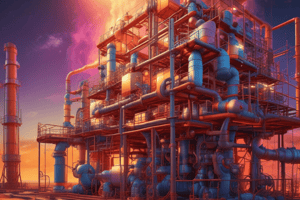Podcast
Questions and Answers
In thermal oxidation of silicon, what does NI represent?
In thermal oxidation of silicon, what does NI represent?
- The number of silicon atoms in the substrate.
- The thickness of the silicon oxide layer.
- The rate of silicon consumption during oxidation.
- The number of oxidant molecules incorporated per unit volume of oxide grown. (correct)
What is the approximate value of NI for $O_2$?
What is the approximate value of NI for $O_2$?
- 4.4 x $10^{22} cm^{-3}$
- 2.2 x $10^{22} cm^{-3}$ (correct)
- 1.1 x $10^{22} cm^{-3}$
- 0.5 x $10^{23} cm^{-3}$
What are the primary factors influencing the oxidation rate besides temperature and pressure, as indicated in the text?
What are the primary factors influencing the oxidation rate besides temperature and pressure, as indicated in the text?
- The presence of impurities in the silicon wafer and the humidity levels.
- The type of ambient gas and flow rate.
- The crystal orientation and doping concentration of silicon.
- The shape, thickness and stress of the oxide layer. (correct)
In the context of silicon oxidation, what do γ and β represent respectively?
In the context of silicon oxidation, what do γ and β represent respectively?
What can be inferred from the text about the complexity of oxidation models?
What can be inferred from the text about the complexity of oxidation models?
Flashcards
Thermal Oxidation of Silicon
Thermal Oxidation of Silicon
A process used for growing a thin oxide layer on the surface of a silicon wafer, typically done at high temperatures in the presence of oxygen or water vapor.
Oxidation Process
Oxidation Process
A chemical process where silicon atoms combine with oxygen atoms to form silicon dioxide (SiO2) on the surface of a silicon wafer.
Oxidation Rate
Oxidation Rate
The speed at which the oxide layer grows during the thermal oxidation process. It depends on factors such as temperature, oxidant concentration, and the silicon crystal orientation.
Different Oxidation Models
Different Oxidation Models
Signup and view all the flashcards
Oxidation Rate Factors
Oxidation Rate Factors
Signup and view all the flashcards
Study Notes
Thermal Oxidation of Silicon
- Thermal oxidation is a crucial process in integrated circuit (IC) fabrication
- Silicon dioxide (SiO2) and the Si/SiO2 interface are essential for silicon's dominance in ICs
- SiO2 is easily etched with lithography, masking common impurities (B, P, As, Sb)
- It's an excellent insulator (high breakdown field, stable electrical properties) and passivates junctions
- Thermal oxidation involves volume expansion (~ 2.2X), affecting 2D and 3D structures
- LOCOS (Local Oxidation of Silicon) process is used to grow field oxides (typically 90 minutes at 1000°C in water vapor results in ~ 0.5 cm growth)
- Thin oxides (~ 3-5 nm) are grown over active regions as gate oxides
Oxidation Mechanisms and Models
- Oxidation of silicon typically involves silicon reacting with either oxygen (O2) or water vapor (H2O). The reactions produce SiO2
- Deal-Grove Model: A basic model for oxidation that considers the rate of volume expansion and volume diffusion/chemical reactions, typically used for modeling field oxide oxidation (parabolic model)
- Point Defect Models: More advanced, atomistic approach to modelling oxidation that looks at how chemical reactions, and diffusion occur at an atomic level (involves interstitials and vacancies)
Oxidation Rate and Other Factors
- Oxidation rate depends on temperature, ambient (O2 or H2O), and other process parameters
- Calculated oxidation rates are often presented with graphs of oxide thickness against time
- This process is sensitive to structure; different shapes and thicknesses lead to different rates
Measurement Techniques
- CV (Capacitance-Voltage) measurements are a critical tool to characterize SiO2 and the Si/SiO2 interface
- This method monitors how charges are distributed in the oxide and in the Si/SiO2 interface, which leads to determining several important quantities like oxide thickness and doping concentration
Other Important Considerations
- Stress effects during oxidation are significant, especially in 2D and 3D structures, and must be considered
- Different oxidation environments and conditions will have different rates and outcomes of the process
- Advanced process models and simulations are essential for accurate results and understanding these complex processes
Studying That Suits You
Use AI to generate personalized quizzes and flashcards to suit your learning preferences.




